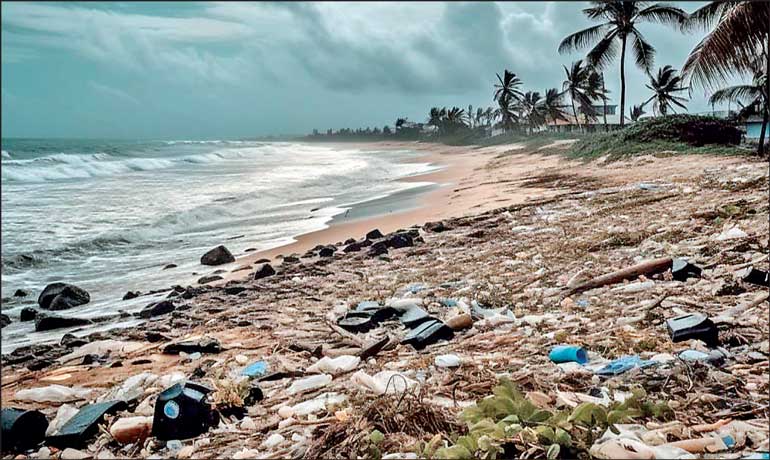Friday Dec 05, 2025
Friday Dec 05, 2025
Saturday, 29 April 2023 00:10 - - {{hitsCtrl.values.hits}}

The objective of the treaty is to protect human health and the environment from the adverse effects of plastic pollution, but many open questions need to be answered regarding its exact modalities
 The second meeting of the Intergovernmental Negotiating Committee (INC) to develop an international legally binding instrument on plastic pollution is rapidly approaching. After a pre-meeting in May 2022 and the first meeting of the INC (INC-1) in November/December 2022 in Uruguay, the second meeting (INC-2) is now scheduled to start on 29 May 2023, in Paris.
The second meeting of the Intergovernmental Negotiating Committee (INC) to develop an international legally binding instrument on plastic pollution is rapidly approaching. After a pre-meeting in May 2022 and the first meeting of the INC (INC-1) in November/December 2022 in Uruguay, the second meeting (INC-2) is now scheduled to start on 29 May 2023, in Paris.
This meeting will bring together member states from across the world—including Sri Lanka—to negotiate key questions on how to develop a global plastic treaty, with a range of non-country stakeholders contributing to the discussion. What are core objectives and obligations for countries under this treaty? How are they going to be achieved and measured? What are the means of implementation, such as finance, capacity-building, and technology transfer? And finally, how are global commitments going to be implemented on the national and local level?
Elements of a global treaty
Ahead of INC-2, the INC Secretariat has prepared a document that presents potential options for elements of an international legally binding instrument on plastic pollution, which are based on UNEP/PP/INC.1/5, the INC-1 discussions, and a synthesis of almost 250 written submissions from member states and other stakeholders.
The document provides an overview of proposals for the global treaty and its modalities, including the preamble, scope, principles, and institutional arrangements, as well as key concepts that will need to be defined (such as “problematic and avoidable plastic products,” “chemicals and polymers of concern,” “circularity,” or “just and inclusive transition”). The Secretariat’s synthesis also contains background information as well as annexes and different options to capture the proposals contained in the submissions.
It is clear that the overarching objective of the treaty is to protect human health and the environment from the adverse effects of plastic pollution, mainly by reducing the production, use, and disposal of plastics throughout their lifecycle. There is also a clear connection between plastic pollution and the planetary challenges of climate change and biodiversity loss, which is outlined throughout the document—for example, in relation to greenhouse gas emissions associated with plastic, the reduced adaptive capacities of plastic-polluted ecosystems, or the ingestion of plastics by wildlife.
However, the exact nature of the treaty is still to be decided, and many questions remain open. For example, what will be the core obligations of member countries, and how legally binding should these obligations be? How can compliance be handled in a way that recognises common but differentiated responsibilities, especially between developed and developing countries, and their respective resources and capacities?
In terms of funding, the INC has to decide if there should be a new and dedicated multilateral fund, or if a new funding window should be added to an existing fund (for example, the Global Environment Facility). There are also questions around other financing opportunities, such as plastic taxes, product charges, packaging fees, extended producer responsibility, or public-private partnerships. Finally, the INC must clarify how other means of implementation can be provided, including capacity-building programmes, training and education, regional network-building, knowledge-sharing, or technology transfer on mutually agreed terms.
Looking down the line, the Global Treaty will need to connect to the national level, where the actual implementation of actions will take place. Should there be national action plans, and what should they contain? How would countries report on their national actions, and how would this reporting be compiled globally to identify the world’s collective progress? Finally, how does the reduction of plastic pollution connect to social issues and the just transition of those whose livelihoods are connected to plastics, both in the formal and informal sector?
In addition, there are also administrative decisions to be made—for example, regarding the Secretariat and the institutional setup of the governing body, the formation of subsidiary bodies, or the establishment of an intergovernmental scientific body, similar to the Intergovernmental Panel on Climate Change (IPCC) or the Intergovernmental Science-Policy Platform on Biodiversity and Ecosystem Services (IPBES).
Sri Lanka and a Global Plastic Treaty
For Sri Lanka, the development of a Global Plastic Treaty is significant for several reasons. South Asia has been identified as one of the hot spots of plastic pollution, with some estimates putting the region as the third largest producer of plastic waste. Additionally, Sri Lanka is an island country and therefore particularly exposed to marine plastic pollution, which causes serious issues for coastal and marine biodiversity, the fisheries sector, and the tourism industry. Furthermore, waste management value chains in the country provide livelihoods for many people, and any intervention should take their needs and vulnerabilities into account.
As a member country to the INC, the process presents Sri Lanka with an important opportunity to engage on plastic pollution on the global stage as well as the national level. Already, the country has made submissions into the process, first ahead of INC-1 and again this year in the lead-up to INC-2. By further participating in the negotiation process, Sri Lanka could build alliances and partnerships with other countries facing similar challenges; potentially create joint initiatives and actions; and gain better access to knowledge and good practices, technical assistance, technology, and funding.
Engaging in the process of developing a Global Plastic Treaty could also help Sri Lanka to identify gaps and opportunities in its existing policy and regulatory environment and lead to more effective national policies and waste management systems. By harnessing synergies, this could also contribute to making progress on the Sustainable Development Goals (especially SDG 12) and national commitments on climate action (for example, Sri Lanka’s Nationally Determined Contributions have identified waste management as a priority sector for the country).
Furthermore, the INC process brings together countries from across the world for the first time to develop a legally binding instrument on plastic pollution. This unprecedented and historic occasion could be utilised to raise awareness on this critical issue and increase public engagement in the reduction of plastic pollution, for example, through recycling initiatives, beach clean-ups, waste avoidance, and development of alternatives to single-use plastics, such as biodegradable and compostable plastics.
Sri Lanka’s participation in the Global Plastic Treaty process offers opportunities to align national with global policies and better address plastic pollution, access knowledge and resources, enhance international cooperation, promote sustainable development, strengthen climate action, and raise public awareness.
(The writer works as Director – Research and Knowledge Management at SLYCAN Trust, a non-profit think tank based in Sri Lanka. His work focuses on climate change, adaptation, resilience, ecosystem conservation, just transition, human mobility, and a range of related issues. He holds a Master’s degree in Education from the University of Cologne, Germany and is a regular writer to several international and local media outlets.)